"Chance Of A Lifetime Voyage - Sail of the Century 2001"
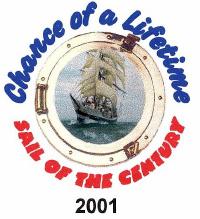

So, you are one of the ‘good’ kids in your class, the ones that go unrecognised because they don’t cause problems. You’re hardworking, especially within your local community, you may have even suffered a family tragedy and just got on with it and helped others as much as you could and all the time you see what those other kids are getting.
You know, those youths that are in trouble constantly with the Police or other authorities, the ones that steal, rob and fight. Well, they seem to get all the attention and they get the holidays, the camping trips, the sports gear to try to get them back onto the straight and narrow and what do you get for already being there, for not causing disruption, for not being a burden, for helping where you can - you get nothing!
Except, that is, on the Wirral. In 1997 the local Police officers of Merseyside Police decided that it was time to reward those that were not a problem to the Police, those that helped in their community, those that overcame personal adversity. So, mostly in their own time, Police officers went to national and local businesses and public bodies and found that there was a strong feeling that ‘good citizenship’ should be rewarded and so the ‘Chance of a Lifetime’ adventure programme was launched (pun intended).
By raising substantial sums of money, by receiving kit donations, by approaching schools, colleges, youth organisations, the officers have chartered a tall ship from the Sail Training Association for a fortnight during the summer to take between 36 and 90 deserving young people from the Wirral on a voyage during each year. The local Hoylake Sailing School provides some basic training and Police Officers go along as the volunteer crew.
The 2001 charter was called ‘The Sail of the Century – 2001’. It started at 6.00 am on a dark August Bank Holiday Monday in Birkenhead, where the local bus company ‘Arriva’ provided a double decker and two drivers to take the crew to Portsmouth. So, dressed in their ‘Valvoline’ sponsored T-shirts and clutching their ‘Birkenhead Market’ sponsored bags the crew headed for the southern coast of England to sail a tall ship.
Portsmouth on this day was a bit busy; the ‘Festival of the Sea’ was in full swing and the brand new, two masted brig ‘Prince William’, the crew’s home for the next nine days, was a welcome sight after having to lug your heavy kit past crowds of happy sightseers and clambering over the Mexican Training Ship ‘Cuauhtemoc’ to get to the ‘William’.
Twenty four hours of training later and the young crew have to ‘man the yards’ (I suppose nowadays we should say ‘staff the yards’) to take part in the parade of sail into the Solent. So you’re 16 years old, you’ve rarely been outside of the Wirral and here you are on a bright Tuesday morning 20 metres in the air, standing on a thin rope, clinging on to a piece of wood and having to wave and cheer to crowds of people on the nearby shore. It gets worse, much worse. At least it wasn’t raining and the sea hadn’t yet gone crinkly.
We motor around the corner of the Isle of Wight into Sandown Bay to anchor and to practice setting the sails and bracing the yards. Some of the crew clamber up the rigging like they’ve never left their ancestral roots, others discover their fear of heights and find it an act of terror and courage to reach the yards. Once sufficiently practiced, its up anchor, set all sail and like centuries of British mariners before them, fair stood the wind for France.
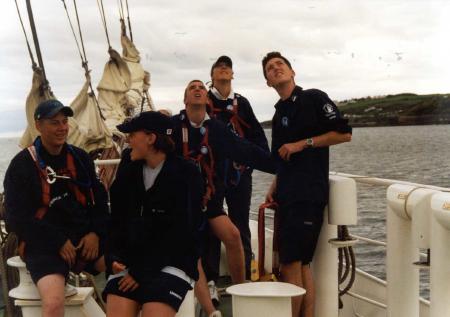
This is when you realise that there are twenty four hours in the day and you are about to experience all of them. You also discover that the English Channel is a very busy place and you are now running across one of the busiest shipping motorways in the world in the dark. All those stories of fully laden supertankers that take five weeks to bring to a halt, having no more than a drunken, incompetent half wit and his dog on the bridge (the dog watching the radar whilst steering), come to mind. This tends to sharpen the senses.
Also the sea is developing the customary ‘channel chop’ and some of the crew are discovering another similarity they never realised they had with Admiral Lord Nelson, apart from sailing from Portsmouth. He was always violently seasick at the start of a voyage.
The entrance to Cherbourg outer harbour is quite impressive, especially when you realise that it was we that caused the French to build all those spectacular fortifications. On a pleasant Wednesday morning we docked at the international berth in the same place where the Titanic berthed some ninety years previously. A quick change of currency and the fleshpots of this port were ours for the taking. Well, whatever you could get for two hundred francs anyway. We ended up in the premises that, during the German occupation, had been Gestapo Headquarters.
After an overnight stay we had interwatch competitions of ‘heaving the line’ (mind your heads) and ‘tug of war’ (mind your bottoms) before heading back out into the channel and the next leg of our adventure. The idea was to recross the English Channel and turn left towards Ireland along the southern coast of England. However, there was an interruption. One of the crew had been taken quite seriously ill and in the early evening off the coast near Dartmouth we had a dramatic rendezvous with a Coastguard helicopter.
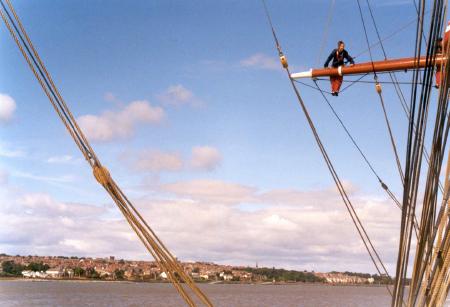
A sailing ship is a helicopter pilot’s nightmare, all those masts and yards and rigging and only small areas available for limited evacuation use. So the helicopter slowly and carefully maneuvered behind the rear of the ship as we sailed in a perfectly straight line and on the second attempt managed to lower the winchman onto the very rear of the ‘William’. The helicopter then circled until the casualty and the winchman were ready, then part two of the drama took place. Again slowly and carefully creeping up to the rear of the ‘William’ until we could grab the winch line. The casualty and winchman are swung off the rear of the ship and onboard of the helicopter. Then to our shouts of goodwill and get better the helicopter clatters off to Hospital.
The casualty fully recovered and to our delight was at Wallasey docks to welcome us when we returned to the Wirral. We lost no time in getting her back on board and up the rigging to wave to everybody for the homecoming.
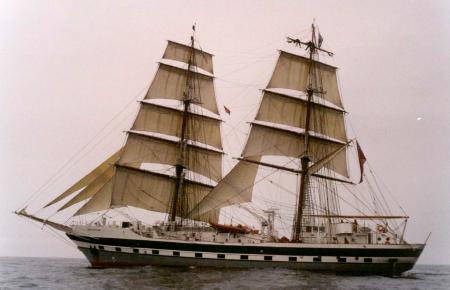
Now the excitement of the rescue is over its time to settle back into the watch routines and head overnight for Lands End. Although not particularly windy the sea was quite choppy and it was like trying to sleep in a bouncy castle with somebody jumping up and down on it. Friday morning was bright and clear and we could see Lands End off to our starboard (right side to you lubbers). Then we sailed into the strip of water across the southern stretch of the Irish Sea where it joins the Bristol Channel heading for Cobh in Eire.
You know when you are close to Ireland because ‘Irish sunshine’ appears, that is it starts raining. We were no exception and on a wet dripping Saturday morning we entered this magnificent and historic anchorage. With crew manning the yards and the bagpipes wailing a welcome to Ireland we sailed towards our berth. This was the interesting bit, the berth allocated to us was 60 metres between an Irish warship and a sea going tug. We were 59.5 metres long, that’s just roughly 20 inches of room. I have never seen such parking ability as Captain Bob Stephenson shoehorned the ‘William’ into that restricted space.
Cobh is an interesting place, the last port of call for the Titanic and the place to which the survivors and some not so lucky from the torpedoed Lusitania were taken. It was also one of the main emigration ports to America and has a small but fascinating museum based on this fact. On Sunday we said our farewell with the yards manned and bagpipes playing and a small escort of local pleasure craft.
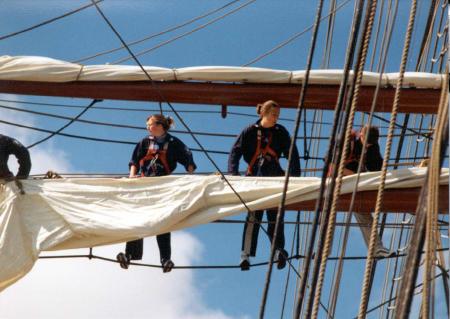
Unlike the initial hesitation there is now fierce competition amongst the crew to be on the highest possible yard whatever the opportunity, especially entering and leaving harbour and because of the restricted numbers allowed so high up at one time, there is many a miserable expression at being sent to the lower yards.
All sails are set and we head eastwards along the southern coast of Ireland. Monday morning brings dolphins to the delight of the whole crew, who gather at the front of the ‘William’ to watch a school of five as they race down the side of the ship, leaping out of the water in a typical display, before whizzing back down to the stern and then repeating the process for about ten minutes, then they are gone.
The afternoon’s main attraction, apart from sailing, was the ‘egg drop’. Each of the three watches has to wrap a raw egg in whatever is available, think of a suitable story and then throw the egg from the yards onto the deck below. Whichever egg doesn’t break is judged the winner. Well, both the ‘egg baby’ and ‘eggtreck’ went over the side and were disqualified, which left the white watch entry as the only survivor and as the egg hadn’t broke, they won. The other eggs were never seen again.
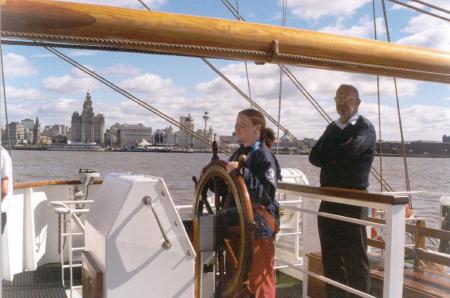
Tuesday morning found us between Anglesey and the Isle of Man. It’s quite amazing the amount of gasrigs that litter this part of the Irish Sea. By 11.00 am. we are at the ‘bar’ and heading in to the Mersey. For the last time the crew man the yards for the homecoming into Wallasey Docks. Parents, friends, relatives, media and police officers are treated to the bagpipes and chants from the crew as we dock. Although tired and needing a good bath the trainees don’t want this wonderful experience to end, unfortunately they have now had their ‘chance of a lifetime’. The police officers who run the programme are already getting ready to organise the next year’s voyage for the deserving young people from the Wirral.
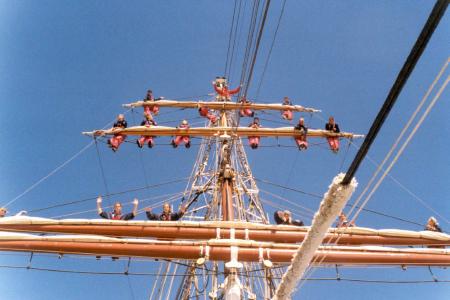
One of the main bonuses of this programme is seeing the personal development of the individuals who take part as the crew. The amount of phone calls and letters from grateful parents amazed at the improvement in their offspring who have now discovered ‘cleaning skills’ and communication skills that beforehand did not exist. The boost to their confidence through their involvement in the venture increases their chances of finding employment and of continuing their reputation as good citizens.
This website is designed and maintained by Bob Williams.
© Copyright Italia Connections 1998 - 2002